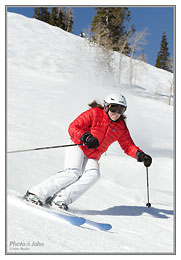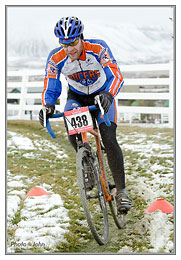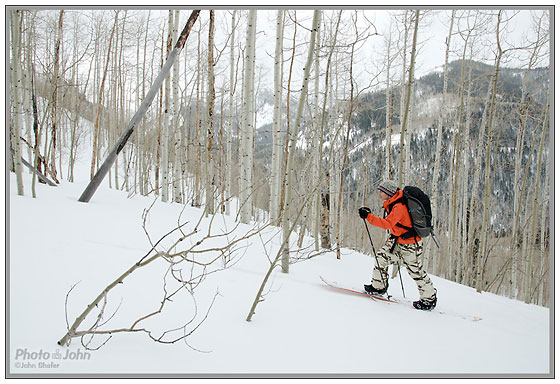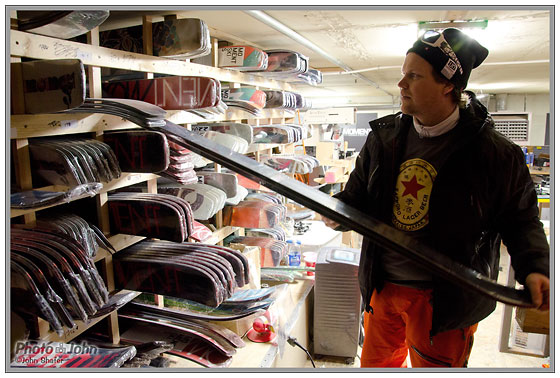My experience last year with the Nikon D3s left me with lots of warm fuzzy feelings about Nikon digital SLRs and I had high hopes for the D7000 being a solid competitor for the Canon EOS 7D – my daily driver. Nikon sent me the D7000 kit with the AF-S 18-105mm f/3.5-5.6 VR lens – not a pro lens, but a versatile all-purpose zoom. I also got Sigma to send me their new top of the line 70-200mm f/2.8 OS HSM pro zoom so I could do some serious outdoor action shooting with the D7000.
The first thing I did with the D7000 was take it up one of the canyons here in Salt Lake to shoot some sample video clips. The video quality is beautiful – as expected. But what I was really interested in was the continuous auto focus performance in movie mode. I tried a few things, including panning between a tree and a rock about 20 feet apart as well as skiers on a bunny slope. Overall, the movie mode continuous auto focus works pretty well, although I wouldn’t consider it a professional-level tool. The contrast-detect auto focus system has a little trouble keeping up with a moving subject. It’s fine for casual photographers who want to get some personal video of their kids or pets. But it’s not yet up to par for professional sports or anything like that. This isn’t a knock on the D7000′s auto focus system. For still shooting, it’s excellent. But the Live View / movie mode’s contrast-detect auto focus system doesn’t even come close to the phase-detect system used for still shooting. It also can’t compete with the movie mode continuous auto focus on the Sony Alpha A55.
Nikon D7000 Sample Video:
I advise you to skip this paragraph if you don’t want to read a bunch of technical gobbledygook about auto focus. Because there’s a lot of hype about digital SLR video, I want to give some technical background on the difference between contrast detect and phase detect AF systems. Contrast detect is used in point-and-shoot cameras as well as for Live View and video on digital SLRs. It works great if you can pre-focus but isn’t quick or accurate enough to track fast-moving subjects. Phase detect auto focus is far quicker and more accurate and allows pro sports photographers to get tack-sharp photos of athletes in motion. The phase detect AF sensor array is located on the mirror in a digital SLR. The mirror has to be locked up to expose the sensor for Live View and movies making phase detect auto focus impossible for DSLR video. The only exception is Sony’s new Alpha SLT camera line, which uses a transparent mirror so the imaging sensor and phase detect auto focus array can be used at the same time. I chose the Sony Alpha SLT-A55 as the 2010 PhotographyREVIEW.com Camera Of The Year, in part, because of its transparent mirror and movie mode auto focus. Nikon deserves credit for being first with movie mode continuous auto focus in a digital SLR but the video AF performance can’t compete with the Sony A55.
 |
 |
|
| Nikon D7000 continous auto focus action photo samples – click images to see them larger | ||
Although I dedicated a bunch of space to explaining DSLR video auto focus, I remain a dedicated still photographer. The main reason I wanted to use the D7000 was to see how it performed as an outdoor action sports camera. I was able to shoot a cyclocross race and a bunch of skiing and the camera did not let me down. My biggest concern for action shooting is always auto focus performance – especially continuous auto focus. The D7000 auto focus was consistently excellent. For a lot of action sports the difference between an OK, bad and great photo happens in hundredths or even thousandths of a second. The D7000′s six frames-per-second burst rate and excellent continuous auto focus stack the odds in the photographer’s favor. That’s not to say that every shot was perfect. A cyclocross racer accelerating towards the camera while it’s snowing would be problematic for any camera. But I got plenty of sharp, useable photos even in those challenging conditions. The only cameras I think might have done better are the Nikon D3s and the Canon EOS-1D Mark IV – both top-of-the-line pro bodies that cost almost five times as much (Nikon D3s vs Canon EOS 1D Mark IV article).
It’s not all about action and auto focus, though. I know the majority of our readers aren’t sports photographers and I don’t shoot sports all the time, either. The D7000 was also excellent at day-to-day photography like portraits, landscapes and snapshots. I especially enjoyed using it in low light situations. I shot a conference and a ski factory tour in poor light and the photos came out great. The D7000 gave me the confidence to pump up the ISO and just blast away without worrying about poor image quality.
After using a few Nikon DSLRs I’ve become fond of their focus point selection system. With the D7000 you just press the four-way controller on the back of the camera in the direction you want to move the focus point. To return to the center you just press the OK button. The simplicity and intuitive design of the control makes up for it being easier to accidentally move the focus point. Its touches like this and the Live View lever that are making me start to appreciate Nikon’s camera design. I still wish they’d stop making all their dials turn the wrong way, though.
I only had one real problem with the D7000. I am usually a manual-exposure-mode guy but sometimes I use aperture or shutter-priority and exposure compensation. With the D7000, when I’d go back to manual mode, the exposure compensation adjustments I’d made in the auto modes still affected my exposure. Since no other camera maker does this – at least not that I know of – I didn’t realize the exposure compensation was still on and I just thought the D7000′s metering was really wacky. I remember the same thing happening to me with the D3s last year. I’m sure it’s no big deal to longtime Nikon users. But I would prefer that exposure adjustments be specific to each mode and exposure compensation be disabled in manual mode.
Next – Nikon D7000 Image Quality >>
| Nikon D7000 Review Navigation | |||||
|
|||||





Three years ago, a camera with this level of performance was out of my price range, so I bought an entry level DSLR, that was supposed to tide me over for a few years until something like this was available at this price. My choice came down to the D40 vs the K100D. Since my AIS glass wasn’t really usable on the D40, and the K100 gave more value for the money, I went with Pentax.
Three years, a couple of intermediate bodies, and an insane number of photos later, I just bought a K-5, and am nearly ecstatic with the camera.
If these two cameras had been available at their current price back then, I would have probably gone Nikon rather than Pentax, just to make use of the lenses I already owned. I’m very curious to see how the two cameras compare in real world use. I do a lot of low light dance photography. Last Friday I was hand holding my K-5 and shooting ISO 12,800, f/1.8 at 1/10-1/25 second at 31mm, and I’d be hard pressed to give up image stabilization at f/1.8-1.4.
I don’t feel that one camera can be said to be better than the other, but I’d love to see where each camera excels in relation to the other.
On the subject of the dials and exposure compensation-
The dials can actually be reversed. It’s a custom function, probably under “Buttons and Dials”, although I don’t have a D7000 to check with. You can both reverse the direction they adjust in and switch which ones control aperture and shutter speed.
As for the exposure compensation, it’s actually quite useful in M mode when working with TTL flash, especially Nikon’s wireless CLS system. It allows you to quickly adjust the flash power while maintaining a chosen shutter speed and aperture.
Oh, and the intervalometer isn’t actually new. It’s been available on higher-end models since the D2 series, and the D300, 700, and D3 also have it.
Max-
Thanks for the comment and thanks for correcting my error about the intervalometer. It’s hard to get every fact straight and not miss any details. So many details…
As for the dials – yes I know you can switch them in the menus. I just don’t And I don’t get why Nikon doesn’t just go along with everyone else with the dials. On the other hand, if they did, maybe they wouldn’t be Nikon anymore. They’ve always been a somewhat obstinate company and it would be wrong to say it hasn’t worked for them
Larry-
I’d really like to review the Pentax K-5. It’s been quite a while since I did any serious shooting with a Pentax digital SLR. We need to get this site caught up on the latest Pentax has to offer. And yeah, it would be good to see how that camera compares with comparable Nikon and Canon bodies. I’ve been hearing lots of good things about the K-5.
John, Great write up of the D7000, I’ve been drooling over this for awhile as I save my pennies for my first DSLR, I got to play with one the other day at Costco, good thing the wife was with me to keep me from buying it outright $1799 with a 18-200mmVRII and other goodies was very tempting. The video’s actually better than I thought it would be and seems like for what I shoot it’d work pretty well, I’m just always worried that I should save some more and hold out for a full frame like the future D800 or something, I guess that’s a never ending dilemma though isn’t it…
BTW thanks for making Utah look so cool, nice to see a pro review coming out of this great place. Need to show some redrock!
Max, John, I recently bought a D7000, and one of the first things I did was reverse the Command dials. It was very easy, and I really prefer them that way. In general, the customization options on the camera are excellent.
I understand what you guys mean about reversing the dials. Coming from any other system, it must be difficult. Nikons dials feel right to me, but I suppose that’s because I learned to shoot on them, and have been using AF Nikon cameras for the past 15 years.
What’s much harder is getting used to the zoom and focus directions, I think. I know that when I was working for a Canon paper, it was very hard to switch back and forth.
My impressions of the D7000 after a week of shooting it.
First off thanks to the person who tipped me off on reversing the dials… Coming from this being my first Nikon Camera it was driving me absolutely bananas.
The lack of any kind of audio or exposure meter in video mode is a real drag.
Images seem to have a cool blue tint to them in AWB, anyone else find that to be true?
Against my better judgement i bought this body with the 18-105mm kit lens which is absolutely horrible, i’ve got a 28-70 2.8 on the way and it won’t be here any to soon.
The one thing that I do love about this camera coming from the Canon world is there is a button for everything right on the body. No digging through menus, so ergonomically it gets a 10.
I’m trying hard to LOVE this camera, but so far for me it’s been a love/hate relationship. I’m hoping better glass will make me 100% happy with the D7000.
Good reviews Dan and John.
Cris Mitchell
I got my Nikon D 7000 with the kit lens 18~105. I find the combination good and the kit lens is sharp, focuses fast even in low lights.
I also bought a 35mm 1.8G which is super sharp and fast.
I am now planning to add a few lenses like 50mm 1.4 G, 105 f2.8 VR micro. I also read a review of the new 28~300 VRII.
Would love to have suggestions on these lenses and more.
I usually do landscapes, portraits, and birds, besides family photographs.
I am armature hobbiest.
Now this is what I call a review! Thank you for not rehashing a general review about the specs that can be read from any spec sheet. Thank you for going into your own personal experiences and siting a comparision to the D3s and Sony Alpha. Your camera experience w/D7000 was very insightful and gave great perspective into how far Nikon has come in terms of DSLR evolution. Thanks.
The D7000 is looking really hot. Maybe its time to trade up from the Sony Alpha to the D7000.
Derek-
Maybe you should wait for my Sony Alpha A55 review – it’s on deck, next up for review
Glad you liked the review. Our goal with reviews is always to talk about real world useablility over specs. Anyone can spew out a big list of specs – you can do that without even having the camera in your hends. But specs will never accurately tell you what the real world experience with the camera is like.
Ok i’m not to proud to admit when i’m wrong especially when it happens all the time
After much frustration with the d7000, having spent a week testing and pouring over the manual and a few ebooks I bought on the camera, I noticed a few things that were set weird on the camera D Lighting was turned on etc… so thinking that someone had possibly been playing with the camera at best buy before i purchased it i decided to do a total reset of the camera … probably should have done that a week ago and saved myself much angst. The reset made all the difference in the world, the camera is now firing on all cylinders the 18-105 kit lens while still not great in my book is totally adequate as a walking around lens, light and get’s the job done.
I purchased a Mamiya 645 to Nikon F Adaptor which arrived in the mail today and let me just say WOW, Mamiya glass on the D7000 body is stupidly stunning.
I retract my last post, I’m now 100% happy with my purchase of the D7000, ok well if they fix the Live View issues i’ll be 100% let’s say 98.9 %
Great Camera, Great Review of it.
Cris…
Cris-
That’s great news. When experienced photographers say they don’t like something it’s sort of hard to argue. We all have different styles and tastes and sometimes it just comes down to that. Plus, I hadn’t seen your photos so I couldn’t say if I thought something was wrong. I can only go off my own experience, which was very, very good. So I’m happy to hear you’ve sorted it all out and we’re more or less on the same page. I really do think it’s a great camera – even if the image quaity doesn’t walk all over the 7D like I expected it to.
By the way, thanks for mentioning the metering in Live View. I missed that when I was writing my review. I am aware of it now but when I was using the camera I immediately found a workaround (switch off Live View and meter with the viewfinder) and then never thought of it again. But you mentioning it in the comments section gets the information out there, so thank
I got myNikon D7k and shots taken were amazingly shap & Crisp, the only thing that i don’t like about is when i brought it out at night and outside temp was 14-15 deg., the movie rec.mode doesn’work!!! i brought it back home and tried at room temp. and it works!!???
Thanks for adding your experience to the discussion, Randy. Are you talking 15-degrees Fahrenheit or Celsius? I’ve shot video with the D7000 at temperatures below freezing although I’m not sure I’ve done it when it’s that cold. I have heard of other cameas having problems with video at temperatures below freezing but that still doesn’t sound right to me. Did you take it right out into the cold and try to shoot video? Maybe the abrupt shift from warm to cold gave the camera problems. When I’ve shot cold video I’m usually out for quite a while before I actually shoot anything so the camera has had a chance to cool off.
You might want to try posting a question on our video forum, too. This is the kind of thing that the dedicated video guys might have an answer for.
My son and I just came back yesterday from doing a commercial medical video shoot in Hawaii. Up until now, we had been shooting with rental Canon 5D Mark II bodies and rented lenses. Good stuff, although the Juiced Link audio input was a real kludge, not to mention a real battery eater. 5D Mark II can be finicky about which CF cards you use.
Why rent? We both own a lot of Nikon glass, and didn’t want to have to invest in its replication. So we have been waiting for a Nikon version of the 5D Mark II, full frame shooting 1080p video.
At my urging, my son did some research on the D7000, and with considerable skepticism, agreed to test the D7000. Within 24 hours, he called to pronounce it superior to the 5D Mark II in ease of handling and competitive web-video quality. I immediately bought a second body, and it arrived the day before we left.
For several days, we shot simultaneously with both cameras, one with a lavalier mike and one with a Rode shotgun; one with a Nikon 85mm f1.4 or a Nikon 50mm f1.4 on the subject’s face, and the other with a Tokina 11-16mm or a Nikon 35mm at a different angle.
We also had a bit of time to see Oahu, I did a lot of shooting of scenics and a bit of indoor stuff (dark Japanese temple). I shoot only in RAW, so I cannot tell whether what I found would be comparable if I shot in jpeg.
Conclusion:
1. Video is outstanding. Need to set up so we can listen to the audio in while recording. Would be better if monitoring built in. Rode mike + D7000 is absolutely AMAZING.
2. The sensor is amazing. It blows away the Canon sensor in dynamic range accommodation.
3. Quality of stills at ISO 1600 is darn close to that of the D300 at 400, and ISO 3200 is easily better than 1600 on the D300. I never had the confidence with the D300 to shoot it ISO 3200, so I have no comparison. I found
4. The autofocus for stills on the D7000 is CLEARLY superior to that of the D300. I generally hate the results of the Nikon 18-200 first-generation zoom on the D300. I was amazed at how much more accurate it focuses on the D7000. I am anxious to try the D7000 with my big Nikon 80-200 f2.8 zoom, which was similarly problematic on the D300.
5. The D300/Nikon 35mm f2 is a deadly sharp combo. Ditto with the D7000. I did a few street shots at ISO 3200 with the D7000 and the 35/f2. Again, the dynamic range of the D7000 imaging chip was amazing.
6. I have no interest in video autofocus. My son correctly maintains you have to learn to use manual focus in video mode. The slightest focus hunt would be unacceptable, as would the noise.
7. Quiet mode is interesting. Essentially useless because of lag, but interesting.
Bottom line: The D7000 is a winner. Can’t wait to see a full-frame 1080p Nikon (D800?) when released.
Mel
I decided to test how my new D7000 compares to my D300 in resolution and general rendition. I set up my tripod about 15 feet away from a shelf, and shot both images with a 55mm f2.8 Nikkor, wide open, 200 ISO, 1/50th second.
Here is the D7000 image:
https://picasaweb.google.com/melsnyder/D7000VsD300#slideshow/5590825165226991138
Here is the D300 image:
https://picasaweb.google.com/melsnyder/D7000VsD300#slideshow/5590825164398469090
I think the D7000 is clearly superior
Mel
comparison with Canon is not the true. so if you expected more from D7000 look here: http://members.chello.pl/m.kaluza/HDR_D700.jpg http://members.chello.pl/m.kaluza/HDR_500D.jpg more about that http://forum.optyczne.pl/viewtopic.php?t=14798&postdays=0&postorder=asc&start=150
But it is true. My tests were made very carefully and they haven’t been manipulated at all. I took a look at the samples on the site you linked to and they’ve both had Fill Light applied at 100. I’m not sure what exactly that means in terms of exposure but it does show (if the tests are to be trusted) that the Nikon files can be pushed harder with the Fill Light adjustment than the Canon can. That’s great I still expected the D7000 to be a lot better than the Canon than it actually was in my tests.
I am not even close to professional. I’ve owned D40s and D90s, as well as many point and shoot cameras. The D7K, which I bought last December, out classes anything I’ve seen or used. The pics are fantastic. Videos are great.The camera is easy to use and until Nikon makes a full frame that I would be able to afford. I’ll stick with my D7000.
Says:
August 29th, 2011 at 6:15 pm
i want to know the price for a brand new nikon F80 camera on its on i already no the price of the nikon AF NIKKOR 28-80mm lense if you could help me with that it would be a great help thanks
Stephen – try when I want to find a price on used gear I check the final prices on eBay and http://www.keh.com. KEH is on one of the best sources for used camera gear. The price will be in US dollars but that’s as good a place as any to start.
stephen mccallum
Says:
August 29th, 2011 at 6:19 pm
Says:
August 29th, 2011 at 6:15 pm
i want to know the price for a brand new nikon F80 camera on its on i already no the price of the nikon AF NIKKOR 28-80mm lense if you could help me with that it would be a great help thanks
Best camera i ever owned ! great review